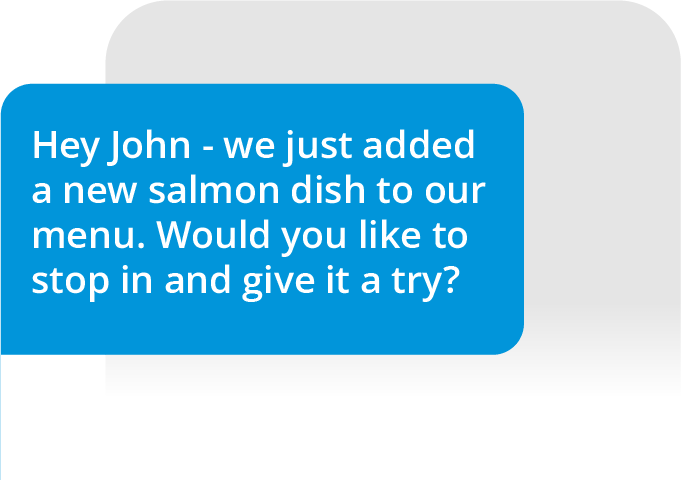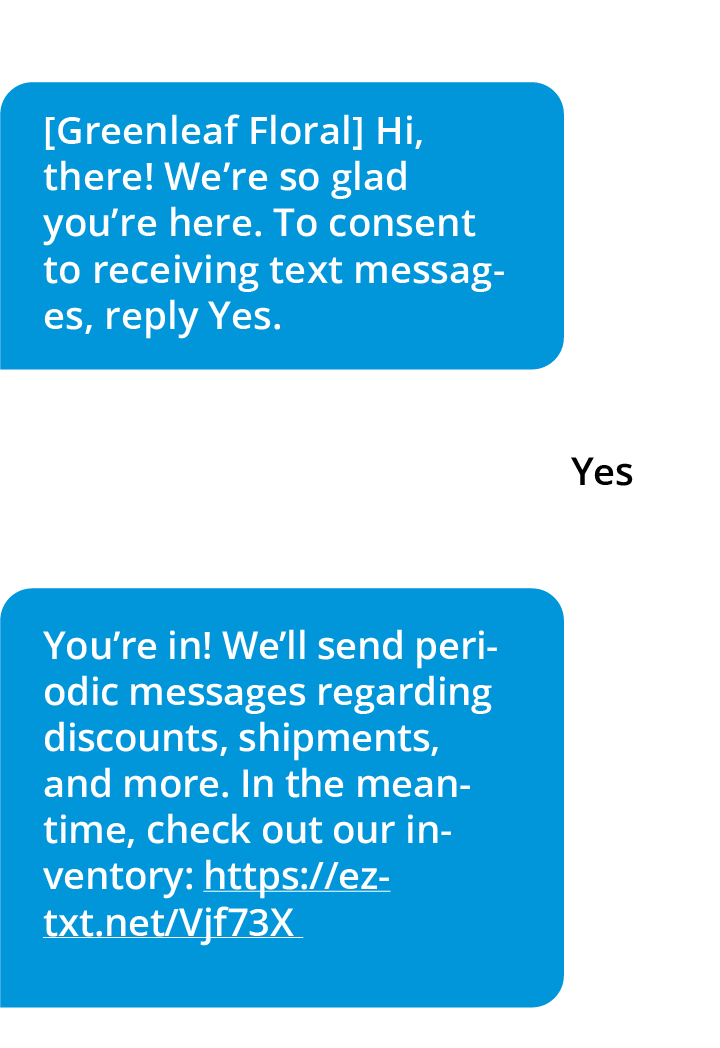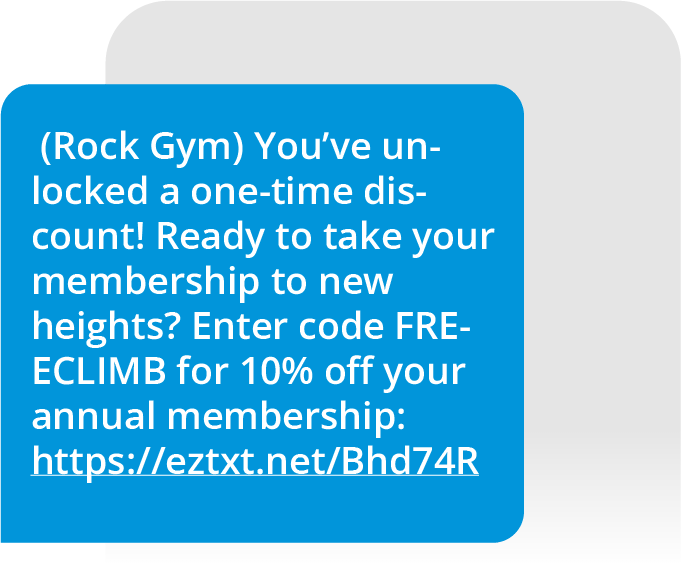6 Texting Errors Most Businesses Make Every Day
Don’t let your marketing messages get caught with typos, missing CTAs, or other texting mistakes — use this guide to understand common texting errors and how to avoid them.

As a marketer, you’re probably aware of the pivotal role that texting can play in your business’s overall marketing strategy. But do you understand how to use it effectively to reach your audience and capture their attention? It’s crucial to know what types of texting errors to avoid so that you keep customers interested, engaged, and coming back for more. Text marketing is a powerful tool that allows you to deploy campaigns quickly. But — if you don’t get everything set up right before you press send, there is no taking it back, and you’ll have an error-filled message sent to your list.
You may already be using texting for your business or may be interested in launching your first text marketing campaign. Either way, you should know about these simple and avoidable texting mistakes before your next promotion spirals out of control.
So, what are the most common texting errors that businesses make? Common texting errors range from sending messages to contacts without permission to not including a CTA or a clear purpose. Read on for all six texting mistakes, plus the ways to avoid them.
Texting Errors Can Damage Credibility & Cost You Customers
Something as simple as not double-checking your message for typos can damage customer credibility. It might be a basic misspelling that isn’t life-threatening, but even small mistakes can cause your customers to lose faith in you and think of you as less professional.
Other mistakes can cause your audience to miss out on your promotion entirely.

For example, let's say that you were having a 1-day sale on Friday, Dec 21, and you sent out the following message:
If you catch it right after it’s sent, you can always follow up with a second message to correct the mistake — but that will damage your professionalism.
However, imagine that you didn’t catch the typo on the date. Nobody would show up on the 21st, and then when they came in on the 28th looking for the sale, they would be very disappointed. That’s just one example.
Read this list of common SMS text messaging mistakes and avoid disastrous campaigns:
#1
Sending Too Many Messages… or Not Enough
Like many other marketing channels, messaging frequency is a delicate balancing act that businesses must master. There isn’t a one-size-fits-all schedule, and finding the right frequency for your business depends on a few different components.
The important thing is that every message you send should provide value to a specific audience segment. Some marketers only send occasional texts and miss the chance to build a meaningful dialogue with their contacts. Others will send multiple texts every day that don't deliver any value.
If you’re trying to find a messaging frequency that works for your business, start with these general guidelines:
- Start by building a text message marketing calendar. On the calendar, highlight at least three days you'd like to send texts each week. A semi-regular and weekly text messaging blast is a quick and easy way to keep your business top-of-mind without being too overbearing.
- Before you press send, ask yourself if you are providing value. You should never send a message just because it's your scheduled day to do so. It's better to skip over a day than to send out something that doesn't have meaning.
- Make sure that all of your messages include an “opt-out code.” You are required by law to include an opt-out mechanism. Plus, your customers may be more forgiving of overly frequent messages if they see that you've given them away to stop receiving them.
#2
Sending the Wrong Type of Message
Text messages are a more intimate form of communication than other marketing channels.
So before you jump in with the same strategies you use for your other channels, stop and think about what your customers want to see in their text messages. If you do this right, you can build high levels of customer engagement, and better brand loyalty, and create an experience your customers will truly appreciate.
On the flip side, if you send the wrong type of message, you will annoy your customers and damage your brand
Don’t Treat Them Like a Mass Audience
We know that text messaging is a mass communications tool. However, recipients should be treated like individuals. Take the time to segment your database by interest, location, or other relevant metrics. Segmentation will allow you to personalize the messages and offers to that specific audience segment.
You can also personalize your text messages by incorporating your contacts’ first or last names. Adding personalization makes it seem like you're having a one-on-one dialogue with them instead of treating them as one herd member.
A great example of segmentation & personalization for restaurant owners would be:

- Sending a message to the popular food and lifestyle bloggers on your list with personalized invitations that invite them to write about a new dish. This might look like this:

- Sending a message to your regular and casual customers that includes more traditional messaging such as promotions, discounts, information about events, and other general offers. For example:
Don’t Try to Sell to Them in Every Message
Even though you're using your marketing to generate more sales, that does not mean every message must include a sales pitch.
Sometimes you can provide much value without asking for your customer’s money.
Some good examples of messages that don’t sell to customers include:
- A destination resort or theme park might offer daily text updates of weather conditions in the area without asking them to stay there or buy tickets.
- A sporting goods store might make a recommendation on a training video for Little League players to watch if they purchased Little League equipment in the past.
#3
Sending Non-exclusive Offers and Promotions
If people opt into your list, they need to feel special. You need to ensure they receive offers and information reserved only for people on your list.
It is okay to send information to them that is made generally available, but there should also be messages unique to them that provide additional added value.
Your subscribers were willing to give you their phone number. They trusted you with this direct contact method. That means that you need to make them feel unique and valued.
- If you own a restaurant, subscribers should get access to exclusive deals and promotions that the general public is not given.
- If you own an event venue, you could open up early access to tickets for people who are on your text message list.
- If you have a place that takes reservations during select times of the year, you could allow your text message subscribers a first chance to make a reservation before you open it up to the general public.
This strategy does more than just make your subscribers feel special. It also gives you a way to track the success of these campaigns.
Because these promotions are only redeemed by the people on your text message list, you can tell how successful they are.
#4
Using Abbreviations or Slang
It can be easy to fall into the trap of using abbreviations and slang when sending text messages to fit your message into the 160-character limit.
However, you don't want to jump on this trend just to make yourself appear “new” or “current.”
It's more important that your messages are clear and concise and represent your own unique brand voice. You don't want to risk someone not understanding what you said just because they are unfamiliar with the abbreviations you used.
Even worse, you risk being potentially offensive if you do not fully understand the slang words that you are using.
You should always strive to use full words except for cases where the abbreviations are very well-known, and that would make sense in any marketing medium, such as using abbreviations for state names or other well-known local places.
#5
Not Incorporating a Call-To-Action
Unlike passive marketing mediums like billboards and TV spots, your text messages should be designed to invite an interaction. Many people fail to take advantage of this by not including a call-to-action or having one that's easy to miss.
If you fail to do this, your SMS campaigns become a friendly chat instead of a powerful marketing channel.
Here's a quick checklist before you send a message so that you can make sure you've got this covered:
- Have someone else on your staff review the message before it’s sent. If they cannot spot the call to action, you need to rework it.
- Every message you send should include some form of a call for a response, even if you are just confirming who's the most involved.
- Consider creating a second elite broadcast list for fans eager to respond to every message.
- You can integrate other media by including an SMS message in your advertising campaign.
#6
Sending to Contacts Without Permission
Sending a contact a text message they haven’t opted in to isn’t just frustrating for them, it might also be illegal. There’s a little thing called the Telephone Consumer Protection Act (TCPA), which requires that consumers provide express written consent before receiving text messages from businesses (basically any organization that might market to them). So, not requesting that consent before sending a text message might drive the contact away and expose your business to legal risk.
Learn all you need to know about the TCPA with the EZ Texting guide to text marketing compliance.
Bonus: Texting Errors Most Businesses Make Every Day
Texting Mistake #7: Not Writing for Your Audience
Knowing your audience is SMS marketing 101, so not writing with them in mind is a crucial text message error. Creating relatable and relevant content is key in text message marketing because it will engage your customers and keep them coming back.
Texting Mistake #8: Overlooking Grammatical Errors and Typos
Typos, incomplete sentences, and misspelled names take a toll on the effectiveness of your text marketing strategy. These text message errors can make your business seem lazy or unprofessional.
Texting Mistake #9: Not Including a CTA
A CTA, or call to action, drives people to your website, blog, event page, and so on. It’s what motivates your audience to take your preferred action. So, it only makes sense that not including one in your text messages harms your business.
Texting Mistake #10: Not Including a Clear Purpose
Businesses that send text messages for any reason aren’t utilizing the marketing method to the best of their ability. Text messages need to include a clear purpose because, let’s face it, your customers are busy! When they take the time to open and read your text messages, they want immediate value.
Texting Mistake #11: Not Learning What Strategies to Use for Successful Campaigns
You've learned much about what not to do to create a successful marketing campaign using text messaging.
You know that you should:
- Be careful not to send too many or too few messages.
- Avoid sending the wrong type of message — like ones that make them feel part of a herd instead of an individual.
- Include exclusive information and offers for your text subscribers.
- Be careful using abbreviations and slang to ensure your message is clear and concise.
- Include an easy-to-find and understand call-to-action. Now it’s time for you to learn what you should do to build a better campaign.
Why Are Texting Errors So Damaging to Businesses?
Texting errors can be damaging to businesses in a couple of ways. For one, texting mistakes can make your business seem unprofessional or not credible due to misspellings, inaccuracies, or irrelevant content. These types of errors can turn people away — the opposite effect any business wants from SMS marketing. Additionally, text marketing errors like a missing CTA, or an unclear purpose won’t drive people to take your intended action, meaning less business and a less-than-stellar ROI.
How Can Businesses Avoid Texting Errors?
Businesses can avoid texting errors by requesting consent, understanding their audience, sending messages at the right times and frequency, proofreading, including a CTA, and providing a clear purpose.

The following tips directly address the six texting mistakes described earlier in this article.
Request Consent
Abiding by the TCPA and other best practices for text marketing compliance is crucial for businesses. Here’s what the opt-in process might look like:

First, the customer might enter their phone number in a contact capture form on your website, or they might send a text to your dedicated number. The next step is super important: In your business’s follow-up text, make sure that you request permission to send the customer messages and provide clear directions on how to opt-out.
If you don’t request consent, future messages might be seen as mistake text messages, quickly disregarded by the contact. Plus, these texts will be non-compliant. Avoid this text message error by always providing clear steps for opting in.
Write Messages to Your Audience
Don’t forget who you’re writing for. Does your audience consist of young adults, business professionals, people who love the outdoors, or travel junkies? Know your audience, and remember them while you’re composing text messages. Use language they’ll understand and resonate with and avoid phrases or topics that might not make sense for that demographic.
But what if your brand audience varies? Use customer segmentation strategies and then craft messages for each segment to meet each customer where they are.
Send Messages at the Right Frequency and at the Right Times
A big difference between SMS marketing and email marketing is the frequency and timing of message delivery. Because people almost always have their phones on them, text messages can be seen as more intrusive than email. So, find the sweet spot for how often and at what times to send your SMS texts.
Depending on your audience, aim to send messages no more than once per week and only within business hours — never on weekends. If you’re unsure, consider sending a survey via text to garner feedback about customer preferences for text message frequency.
Pro tip: Automate appointment reminders, abandoned cart messages, birthday discounts, holiday promotions, and more. Many SMS marketing platforms, like EZ Texting, have text message automation features to minimize manual tasks and help with scheduling. Watch out for certain auto texting mistakes, like not writing for your audience, not including personalization features, and other general text message errors.
Proofread
Don’t overlook the power of proofreading before clicking “send.” If you wrote the copy, have another team member look it over with fresh eyes to catch any text message errors. Run spell-check, ensure discounts or dates are correct, and ensure the customer’s name is spelled correctly.
If your text marketing platform has a predictive text feature, reviewing the copy before sending is especially important. While this feature trims down the time it takes to compose text, it can introduce errors, like misspellings, incorrect words, and other predictive text mistakes.
Include a CTA
Do you want the contact to click a link to your website, reply to your conversational text, or complete a purchase? Always include a strong CTA at the end of your text message, as this will hopefully motivate the customer to take action.

Provide a Clear Purpose
Customers return to your business because it provides value— part of that value is conveyed in your marketing strategy. Ensure that every message you send provides a clear purpose. In other words, customers shouldn’t wonder why they received your business’s text message. Whether it’s a product launch, a nonprofit fundraiser, a one-time discount, or something else, always convey the “why” up front.
How Can Businesses Measure the Success of Their Texting Campaigns?
It’s important for businesses to measure the success of their texting campaigns to see what went right and what they can improve upon for the next campaign. In addition to understanding the types of text message errors they might have made, businesses should also calculate the ROI of SMS marketing and have access to robust analytics.
That’s where EZ Texting can help. Track every interaction, clicks, bounce rates, opt-outs, contact behavior, and so much more — all from one platform. Learn more about EZ Texting’s analytics and reporting, and sign up for your free trial today.
FAQs
Here are some specific examples of texting errors that businesses make:
- Sending to contacts without permission
- Not writing for your audience
- Sending messages at inappropriate times or too often
- Overlooking grammatical errors and typos
- Not including a CTA
- Not including a clear purpose
Here are some tips for businesses on how to use texting effectively:
- Choose the right tone and style, depending on your audience
- Write in active voice
- Use clear and concise language
- Always request consent
- Be engaging and provide a clear purpose
Learn more about how to optimize your texts for success.
A best practice for businesses when using predictive text is to always proofread before finalizing and sending text messages that use this type of feature. Sometimes, predictive text can introduce texting errors, like incorrect word choice or misspellings, so it’s important to review the content for these types of mistakes.
See other resources related to:
